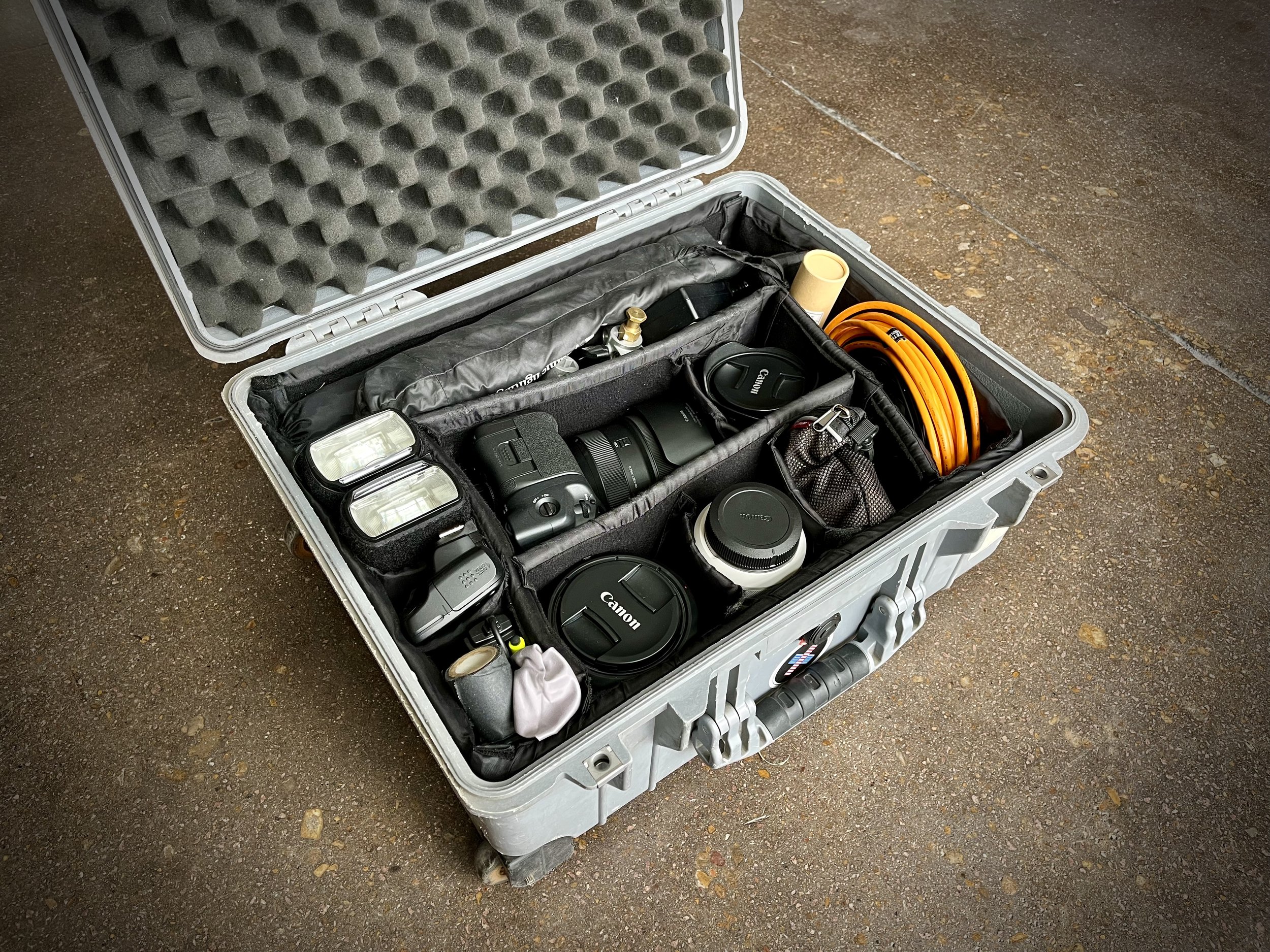How We Pack For A Commercial Video Production
How to Pack for a Video Shoot
Producing a video can seem really daunting when you consider all of the different needs of a project. Every shoot has unique challenges and it’s our job to anticipate those needs. You wouldn’t rush off on a vacation without putting some thought into what goes in your suitcase, right? We have to put that same kind of attention into packing our gear. In this post we’re going to talk about how we plan for a variety of shoots near our St. Louis studio and in locations around the world. We’ll also cover how we secure our critical gear and what systems we use to internally and externally ensure that our equipment is mission-ready for commercial video production.
Packing Basics
Our whole packing methodology is built around bringing the right tools while staying nimble. We love high-speed, low-drag. We want to maximize our capability without sacrificing our light footprint. We continually spec out and purchase the most efficient gear that we can. Unlike many filmmakers we rarely rent equipment. That’s because production rental houses will often only have heavy, tried-and-true equipment. We would need a box truck and twice the team members to move all of our gear if we went that route on every video production. Bulky gear becomes unmanageable on sensitive shoots and rental kits are less efficient. Their camera kits just contain the bodies. Their lens kits are just a box of lenses. Their audio kits live in their own space. Instead, we build our kits by merging the useful bits together.
We prepare for a shoot first by researching and sourcing this state-of-the-art equipment. Then build those into ready-to-travel kits. Through our scouting and client interactions we determine which of these prebuilt kits need to go with us on a shoot. We’ll also scout for things like AC power, terrain, even access to medical attention so we pack the right specialty kits.
We use Pelican cases most of the time because they’re nearly indestructible. We also pack our cases to fall under air travel requirements — even in local shoots. Our cases stay under standard checked baggage size (62”) and weight (less that 50lbs). Our standard camera kit weighs 48.5lbs and we know that if its flying all we need to do is pull the batteries from it and throw a on a lock. We heavily prioritize manageable gear in our build-outs. That becomes especially important when flying because you’ll have some kind of personal luggage in addition to the gear.
When we fly we keep batteries and a bare-minimum audio setup in our carry-on camera kit. That lets us get started on a shoot even if our larger gear kits don’t arrive on time. We can’t put everything in a carry-on, which makes checking bags unavoidable. It’s still smart to carry some basics on your person so that you’re not empty handed if the rest of your gear gets misplaced by an airline. We’re always planning for unexpected issues while traveling. Local rental houses and even shipping gear serve as potential backup solutions on these remote productions.
Pack in the Downtime
Ideally, packing for a shoot should happen right after the last shoot ends. Any equipment problems that arose on the previous shoot can be easily addressed in the downtime before the next shoot starts. For instance, if we couldn’t find a lens cloth in our kit earlier we’ll throw another in where it should’ve been. Packing when we return from a shoot helps our team stay aware of our own feedback. We use this period of relative calm to repair gear and consider potential problems that we could face later. This is the best time to address the way gear fits in a case or other technical frustrations we might encounter on a future setup.
Its from this methodology and our early work in commercial photography that we developed our series of kits. It’s all gear we frequently use together so we store them together. We duplicate a few general kits with exactly the same cameras, lenses, and accessories. Each kit has a basic checklist and gets put back together at the end of a shoot exactly the same way. This strategy keeps kits ready for the next shoot. Each camera case, light case, and bag gets the same treatment as a ‘crash cart’ in an emergency department — that is to say that we treat filmmaking gear as time- and mission-critical. Every piece of gear has a designated home and is routinely checked. Every piece of gear lives in some pouch, in a specific box, on a particular shelf and if it’s not there we will replace it right away.
Treating everything as prebuilt kits helps us ensure that we have the right tools on location. We don’t have to run through a long checklist before we fly for a shoot- we just grab the two cases we need. Or in many cases, we can just grab the keys to our Sprinter van and head out to the shoot with no additional packing. Even batteries aren’t a consideration most of the time because we charge them from our solar-powered GoalZero system in the Sprinter van.
Dissimilar gear kits still share similar layouts- so we can always find something like a multitool in the same corner of every case when we need it. Consistency is really important. This helps us to avoid cannibalizing our kits and throwing our whole system off the rails.
Our specialized equipment is also setup in kits for ease of deployment. We have standard camera and lighting kits, but also built out gimbal kits, drone kits, power sources, first aid, tele prompting, video villages, and more that are prepackaged and ready for travel. Packaging equipment this way also helps us gauge tiers of equipment needs for estimating projects. Overall, this ‘kit system’ saves us costs in labor hours, administration, and personal stress levels. It makes everything smoother for our clients and they ultimately get better results.
Time and Duplication
Even the best layouts or gear checks can fail by human error. We don’t want to end up at a shooting location trying to remove a camera plate but having misplaced the multitool we thought was in our case. To avoid that situation we also pack duplicates and build in redundant equipment. If we lost a multitool- that’s okay, because every case has one. If we break a lens, we have others with us that can provide overlap in capabilities.
Obviously there are costs to buying, renting or traveling with duplicate gear. Just as there are labor costs in trying to avoid the duplication. Time is money to commercial video production. We have found that it is often cheaper to build duplicate kits than having someone on our production team searching through gear to scrape together messy kits for simultaneous shoots.
We maintain duplicates of all of our most commonly used gear, lenses, and cameras. If we have a really expensive piece of gear that we don’t want to duplicate, we rely on overlapping capabilities from similar equipment. We might bring lenses with different focal lengths but they overlap in the edge of their capabilities. If we want to use a 16-35mm lens, the redundancy for that is a 14mm and 24-70mm. There’s a lot of overlap in that 24-35mm range. We might plan on using a boom mic for an interview but if it rolled under the van we still have lavalier mics in the kit. Likewise, our primary cameras right now are C500s, but we keep backup C70s in our kits to provide similar capabilities if the main camera has an issue.
Service and Maintenance
First and foremost, we don’t work with broken equipment. We don’t baby it, either. When something isn’t functioning we send it off for service. That’s another benefit of redundant equipment. Keeping equipment ready for a shoot while its counterpart is away for service helps tremendously. We have enough equipment to survive more shoots than we have people to utilize it all. It’s a bit like planting in two fields and leaving a third fallow. We maintain a balance of duplicate gear to ensure that we have it when we need it.
Our gear doesn’t require a lot of preventative maintenance. Our cameras are mirrorless and have few moving parts. We blow out dirty kits with compressed air and might clean a dirty sensor here and there. For anything more significant, we send it out for service. We maintain the highest CarePAK repair level that Canon offers. Every time we send a piece of gear out they perform a complete refurbishing process. They fix it and send it back in two days. We fix gear as it breaks and cycle in new equipment often enough that obsolescence doesn’t hold us back.
Conclusion
Packing for a shoot is really an ongoing process. The Once Films production team has put countless hours into refining our gear deployment model. Our process is in a really good place but we’re constantly testing the system and swapping out equipment. What remains constant is the need for redundancy and consistency. The goal is to have what you need where you need it, but that will always have to be balanced with manageability.
Our production staff have our system down to a science. That builds reliability for our clients. They can trust that we’ll have what we need to make their video project a success. It also keeps us operational in sensitive or difficult filming environments, and cool under pressure.





